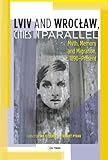Lviv – Wrocław, Cities in Parallel? : Myth, Memory and Migration, c. 1890-Present / ed. by Robert Pyrah, Jan Fellerer.
Material type: TextPublisher: Budapest ; New York : Central European University Press, [2022]Copyright date: ©2020Description: 1 online resource (364 p.)Content type:
TextPublisher: Budapest ; New York : Central European University Press, [2022]Copyright date: ©2020Description: 1 online resource (364 p.)Content type: - 9789633863244
- Forced migration -- Poland -- Wrocław
- Forced migration -- Ukraine -- Lʹviv
- Group identity -- Poland -- Wrocław -- History -- 20th century
- Group identity -- Poland -- Wrocław -- History -- 21st century
- Group identity -- Ukraine -- Lʹviv -- History -- 20th century
- Group identity -- Ukraine -- Lʹviv -- History -- 21st century
- HISTORY / Modern / 20th Century
- Communism, Cultural studies, Language policies, Memory politics, Minorities, Urban studies
- 943.8/52 23
- DK508.95.L86 L855 2020
- DK508.95.L86 L855 2020
- online - DeGruyter
| Item type | Current library | Call number | URL | Status | Notes | Barcode | |
|---|---|---|---|---|---|---|---|
 eBook
eBook
|
Biblioteca "Angelicum" Pont. Univ. S.Tommaso d'Aquino Nuvola online | online - DeGruyter (Browse shelf(Opens below)) | Online access | Not for loan (Accesso limitato) | Accesso per gli utenti autorizzati / Access for authorized users | (dgr)9789633863244 |
Frontmatter -- Table of Contents -- Introduction -- A Place Called Home? Nation, Locality and the “Parallel” Polish- Ukrainian Histories of Wrocław and Lviv -- Population Movement and the Liberal State: The Polskie Towarzystwo Emigracyjne and the Regulation of Labor Migration from Lviv’s Hinterlands -- Jews in Lviv at the Turn of the 20th Century: On the Road to Modernization -- Beyond National: “Posttraumatic Identity” of Disabled War Veterans in Interwar Lviv -- East Meets West: Polish-German Coexistence in Lower Silesia through the Memories of Polish Expellees, 1945–1947 -- Tylko we Lwowie: Tango, Jazz, and Urban Entertainment in a Multi-ethnic City -- Impressions of Place: Soviet Travel Writings and the Discovery of Lviv, 1939–40 -- Imperfect Metropolis: The Evolving Projections of Wrocław in Polish Feature Films -- The Bu-Ba-Bu and the Reorientation of Ukrainian Culture: The Carnival City and the Palimpsestual Past -- Memory, and Lack of Memory, of Others: The Image of the Jewish and the Polish Neighbor in Oral Reflections of Lviv’s Current Inhabitants -- City, Memory, and Identity: The Case of Wrocław after 1945 -- Contemporary Lviv: Facing the Past—Reinterpreting the Past -- Building Bridges Between Breslau and Wrocław: A Case Study from the European Capital of Culture Initiative, 2016 -- Afterword: Central European Cities as Laboratories of Memory… and Oblivion—Lviv and Wrocław Contrasted -- Index
restricted access online access with authorization star
http://purl.org/coar/access_right/c_16ec
After World War II, Europe witnessed the massive redrawing of national borders and the efforts to make the population fit those new borders. As a consequence of these forced changes, both Lviv and Wrocław went through cataclysmic changes in population and culture. Assertively Polish prewar Lwów became Soviet Lvov, and then, after 1991, it became assertively Ukrainian Lviv. Breslau, the third largest city in Germany before 1945, was in turn "recovered" by communist Poland as Wrocław. Practically the entire population of Breslau was replaced, and Lwów's demography too was dramatically restructured: many Polish inhabitants migrated to Wrocław and most Jews perished or went into exile. The forced migration of these groups incorporated new myths and the construction of official memory projects. The chapters in this edited book compare the two cities by focusing on lived experiences and "bottom-up" historical processes. Their sources and methods are those of micro-history and include oral testimonies, memoirs, direct observation and questionnaires, examples of popular culture, and media pieces. The essays explore many manifestations of the two sides of the same coin—loss on the one hand, gain on the other—in two cities that, as a result of the political reality of the time, are complementary.
Mode of access: Internet via World Wide Web.
In English.
Description based on online resource; title from PDF title page (publisher's Web site, viewed 30. Aug 2022)


